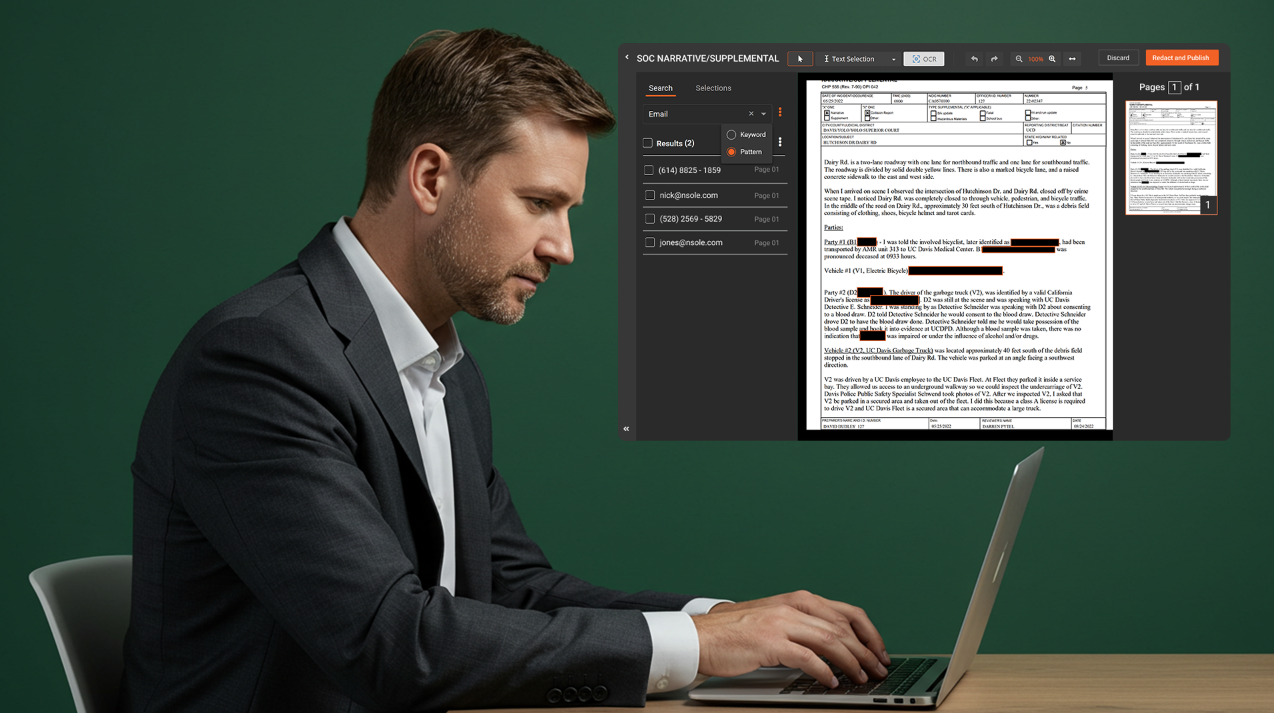How Mass Torts Can Use Healthcare Data Intelligence Tools to Process Cases Faster
by Rafay Muneer, Last updated: November 18, 2025, Code:

Mass torts are now the center of gravity in federal civil litigation. As of FY 2023, about 71% of the federal civil caseload sat inside multidistrict litigations, which are largely driven by product liability matters that flood teams with medical records and complex discovery.
In the same period, the Judicial Panel on Multidistrict Litigation created ten new products liability MDLs, reinforcing how medical evidence drives volume and complexity.
That scale changes what “ready for discovery” means. Mass torts are not just collecting PDFs and producing on time. They are answering factual questions across thousands of charts, aligning timelines, and keeping positions consistent across many plaintiffs. As you can imagine, it’s easier said than done. And it’s putting many firms through the ringer.
This is where healthcare data intelligence tools earn their place. They help firms analyze data with semantic search, entity extraction, and medical record analytics while also helping them redact for HIPAA-compliance so productions are both fast and defensible.
The Data Landscape in Mass Torts
Mass tort teams deal with a messy stream of healthcare data before a single page is reviewed. Understanding what comes in, who holds it, and why it varies so much helps you plan analysis and HIPAA-compliant redaction without scrambling later. This is where healthcare data intelligence tools start to pay off, because they help you see the whole picture early.
Sources and Formats
Records arrive from hospitals, clinics, billing vendors, pharmacies, and insurers. Expect EHR exports and CCDs, scanned PDFs, physician notes, intake forms, lab results, pharmacy histories, payer claims, portal printouts, emails, and texts.
Imaging can include DICOM studies with embedded metadata, plus JPEG or TIFF exports. Audio from intake lines and IME videos often appear alongside documents. Each format behaves differently in search, redaction and review processes.
Custodians and Systems
Data lives across many custodians and platforms. One plaintiff may have a dozen providers, each with a different EHR, plus a pharmacy chain and a health plan.
Third-party retrieval vendors add their own packaging and naming. The same visit can show up multiple times with different file names, page orders, or time zones. Without early normalization and indexing, reviewers chase versions instead of facts.
Volume and Variability
Scale is the rule, not the exception. Large matters bring tens of thousands of files with mixed quality. Scans may be skewed or low-resolution, the untrained eye can miss headers and handwritten notes, and dates or patient identifiers can be inconsistent across sources.
Duplicates, near-duplicates, and partial overlaps are common. These issues slow search, hide key findings, and increase the risk of missed PHI unless triage, deduplication, and clear naming rules are set up front.
Main Challenges Mass Tort Teams Face
Handling thousands of plaintiff medical records is not just about volume. The real issues are accuracy, speed, and compliance under pressure. Here are the pain points that matter most:
Too Much Data, Too Little Time
Plaintiff records arrive from hospitals, pharmacies, insurers, and third-party vendors. With discovery deadlines looming, teams must sift through mountains of unstructured data faster than ever.
Finding Facts Across Messy Files
Scans, PDFs, handwritten notes, and EHR exports are full of inconsistencies. OCR misses text, dates don’t align, and duplicates pile up. Without healthcare data intelligence tools, key details are overlooked, creating risk in court.
Redacting PHI under HIPAA
Productions must remove sensitive health identifiers. But manual HIPAA-compliant redaction is slow and error prone. A single missed patient identifier can trigger sanctions or privilege challenges.
Keeping Outputs Consistent
When multiple firms and vendors touch the same files, redaction codes, reasons, and styles drift. Inconsistency undermines defensibility and frustrates judges and opposing counsel.
Audit and Compliance Pressure
Courts expect clear logs, audit trails, and proof of process. Without reliable systems, teams scramble to defend their redactions, exposing themselves to rework and reputational risk.
How Healthcare Data Intelligence Tools Help
Mass tort litigation is built on evidence, and in large-scale cases that evidence is overwhelmingly medical. Thousands of records must be reviewed, analyzed, redacted, and produced under strict deadlines. Traditional methods struggle under this weight. Healthcare data intelligence tools bring automation, consistency, and defensibility to every stage of the workflow.
Faster Case Review
Teams no longer need to dig through records manually. With semantic search and entity extraction, they can instantly surface patient histories, treatment dates, or medication lists across thousands of charts. This speeds up fact-finding and ensures consistency across all plaintiffs.
Early Error Detection
Duplicate records, mismatched patient identifiers, and inconsistent dates often hide in messy data. AI-powered anomaly detection flags these issues quickly, so teams can clean data early and prevent downstream problems in discovery.
Reliable Redaction
Productions must meet HIPAA requirements. Automated PHI detection and redaction eliminates manual bottlenecks, reduces risk of errors, and produces standardized logs that stand up in court. Teams move from page-by-page redaction to validating AI-suggested redactions at scale.
Streamlined Multi-Format Review
Mass tort evidence is not limited to PDFs. Tools that transcribe call recordings, analyze IME videos, and extract metadata from imaging files let teams process every format consistently. This avoids delays caused by evidence that does not fit traditional document review.
Defensible Productions
Clear audit trails and redaction logs prove compliance at every step. Teams can show when redactions were made, why they were applied, and by whom. This transparency makes productions defensible in meet-and-confers and reduces costly rework.
Consistent Collaboration
Multiple firms and vendors often share responsibility in mass torts. A centralized platform ensures everyone follows the same rules, redaction styles, and production standards. This eliminates drift, reduces duplication, and keeps outputs uniform across the entire case.
How VIDIZMO Intelligence Hub Supports Mass Tort Teams

Mass tort firms need more than a place to store evidence. They need intelligence that makes review faster, productions more defensible, and investigations more insightful. VIDIZMO Intelligence Hub combines advanced AI with secure compliance features to help teams manage thousands of medical records with speed and confidence.
Natural Language Search
All medical records, imaging, videos, and call recordings come together in one secure hub. Instead of jumping between drives and vendors, reviewers can use natural language search across every file type to quickly answer questions like “list all procedures for Plaintiff X in 2019” or “show all opioid prescriptions across plaintiffs.”
Summarization and Timeline Generation
AI-powered summarization condenses lengthy medical files into concise case briefs, highlighting diagnoses, treatments, and key procedures. Automatic timeline generation connects events across different sources, giving teams a clear view of what happened, when it happened, and where inconsistencies might exist.
Fraud Pattern Detection
The Hub helps uncover red flags that are often missed in manual review. AI can detect phantom billing, double billing, and provider conspiracies by comparing records across multiple plaintiffs and providers. What once required weeks of manual cross-checking can now be identified in minutes, strengthening cases and revealing fraudulent activity before trial.
HIPAA-Compliant Redaction
When it is time to produce records, the Hub automates PHI redaction across documents, audio, video, and images. Reviewers only need to validate the results. The system creates consistent outputs backed by redaction logs and audit trails, ensuring every production is defensible.
Multimodal Intelligence
Mass tort evidence often goes beyond documents. The Hub transcribes call recordings, analyzes IME videos frame by frame, and extracts metadata from DICOM imaging. Every type of evidence is searchable and reviewable in the same environment, eliminating the usual bottlenecks.
Defensible and Collaborative
Productions come with redaction logs, redaction codes, and chain of custody reports that clearly show what was removed, why, and by whom. With role-based permissions, co-counsel and vendors can collaborate securely and follow the same workflows and coding standards, keeping outputs consistent across the entire team.
Conclusion
Mass tort litigation pushes review teams to their limits. With thousands of medical records, strict discovery deadlines, and the constant pressure of HIPAA compliance, traditional methods cannot keep up. The challenge is not only volume but also accuracy, defensibility, and speed.
This is where healthcare data intelligence tools like VIDIZMO Intelligence Hub make a real difference. By combining natural language search, summarization, timeline generation, fraud pattern detection, and automated redaction, the Hub helps teams turn raw data into actionable intelligence. Every record becomes easier to analyze, every production is more consistent, and every redaction is backed by codes, logs, and audit trails.
The result is simple: faster case review, stronger compliance, and productions you can stand behind in court.
People Also Ask
What are healthcare data intelligence tools in mass tort litigation?
Healthcare data intelligence tools are platforms that help law firms manage, analyze, and redact large volumes of plaintiff medical records. They use AI features like natural language search, summarization, and anomaly detection to speed up case review and ensure HIPAA-compliant productions.
Why do mass tort firms need healthcare data intelligence tools?
Mass tort firms often handle thousands of medical records across multiple plaintiffs. Without automation, reviewing, analyzing, and redacting these records takes too long and increases the risk of errors. Intelligence tools cut review time, improve consistency, and create defensible productions.
How can AI help in reviewing medical records for mass torts?
AI helps by summarizing long medical files, generating patient timelines, detecting duplicate or inconsistent records, and identifying fraud patterns such as phantom billing. These capabilities allow legal teams to find facts faster and prepare stronger cases.
What is HIPAA-compliant redaction in mass tort cases?
HIPAA-compliant redaction is the process of removing protected health information (PHI) such as names, dates of birth, addresses, and policy numbers from records before they are shared in discovery. Automated redaction with standardized codes ensures accuracy, compliance, and defensibility.
Can healthcare data intelligence tools detect fraud in medical records?
Yes. Advanced platforms can run cross-plaintiff comparisons to flag issues like double billing, phantom billing, or unusual provider activity. Detecting these fraud patterns early helps strengthen arguments and avoid costly errors.
How do redaction codes improve defensibility in litigation?
Redaction codes provide clear reasons for every redaction, whether for PHI, privilege, or confidentiality. Along with logs and audit trails, they give courts and opposing counsel a transparent record of why certain information was withheld, making productions more defensible.
Do intelligence tools handle non-document evidence like videos or audio?
Yes. Modern healthcare data intelligence tools can transcribe call recordings, analyze IME videos frame by frame, and extract metadata from imaging files. This ensures that every type of evidence is reviewable and redactable in the same workflow.
Jump to
You May Also Like
These Related Stories

Best Redaction Software for Attorneys: What Your Firm Needs in 2025

How Redaction Software for Law Enforcement Improves Police Report Redaction



No Comments Yet
Let us know what you think